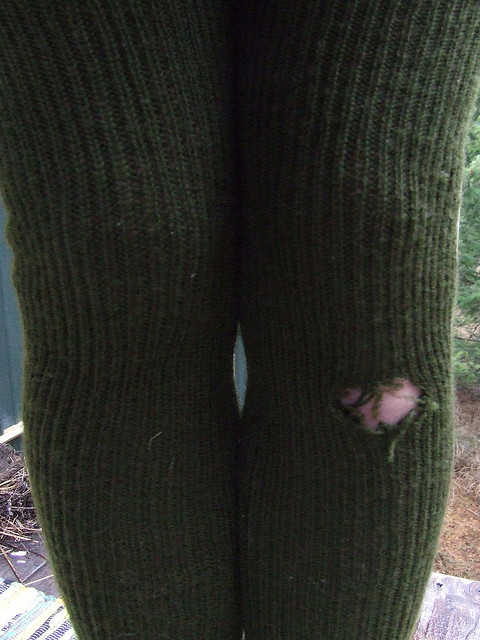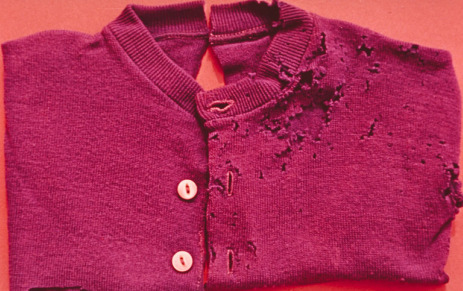Send your question to Umbra!
Q. Dear Umbra,
It’s fall and time to pull out the appropriate warmer clothing. In doing so, I found holes in several sweaters that didn’t have holes the last time I wore them. I’ve also noticed moths flying around my apartment in the last couple of weeks. Coincidence? If not, how can I kill the moths and save the sweaters?
Sweaterless in Seattle
A. Dearest Sweaterless,
 Darn those moths! Now darn these stockings!Photo: knitting irisI see you’ve got a case of varmints in your garments. They would be Tineola bisselliella, or clothing moths for the Latin-challenged among us.
Darn those moths! Now darn these stockings!Photo: knitting irisI see you’ve got a case of varmints in your garments. They would be Tineola bisselliella, or clothing moths for the Latin-challenged among us.
Though you’ve seen moths fluttering about your home, they are not the ones dining on your duds. You see, adult clothing moths don’t have mouths large enough for eating. It’s their big-mouthed larvae that turn closets into all-you-can-eat buffets. They do the damage and then skip out on the check, aka the cost of replacing or repairing your clothes. So let’s discuss moth larvae behavior along with some tips for prevention, eradication, and sweater repair, shall we?
Clothing moths have an appetite for keratin, a protein which is found in the hair and skin of animals. Wool cardigans, cashmere shawls, vintage fur muffs, and feather boas are all keratin carriers and thus tasty main dishes to these moth puppies. The half-inch-long white wormies are also drawn to stains, sweat, dead skin, and other grossness on fabrics. They feed on the soiled stuff, which gives them the nutrition they need to pupate. So, the first rule of moth fight club: Clean your clothes! If you’re worried about your sweaters getting damaged in the washing machine, consider these alternatives to toxic dry cleaning.
Moth eggs probably arrived in your home by hitching a ride on an article of clothing. All the more reason, Sweaterless, to wash any new or used clothes as soon as you get them home. (Note: larvae can live 35 days or longer; adult moths somewhere between 10 and 28 days. At normal home temperatures, clothing moths can hatch, grow, eat, and reproduce all year long.) Once your clothes are clean, store your sweaters in the most airtight, dry environment you can find. Apparently, these munchers like moisture, so keeping your clothes dry will help keep the moths away. Sealed plastic bags and under-the-bed storage bins are good ways to go.
How else can you repel closet gobblers? Well, moths may be attracted to flames, but clothing moths do everything they can to avoid light. Consider having a doorless closet or installing a solar powered light in your bureau. They’ll be out of there and off to darker corners in no time, which brings me to the power of vacuuming. It works wonders when it comes to sucking those little eggs out of floorboards and carpets, primo clothing moth hiding places.
As for repellents, have the balls to not use mothballs. They may be easy to come by and bring back fond memories. But if grandma had known that the main ingredient — paradichlorobenzene — was a probable carcinogen that can cause liver failure and lesions, she might still be alive. Forgive my freshness, but do think about using cedar as your moth beater. Make sure the wood stays effective by sanding it now and again. You can use cedar oil to refresh it too.
Boric acid is a great way to make sure moth spawn will be sleeping with the fishes. It’s non-toxic to humans and pets (unless eaten or inhaled in massive quantities) and can easily be sprinkled in dark moth hideouts. High heat or freezing cold will also do the job. If you suspect sweaters are harboring fugitive moth eggs, you can put them in the freezer for several days to ice the bastards.
For a DIY approach, try makingherbal repellent sachets. Add cloves, thyme, fresh rosemary, lavender, cinnamon sticks, bay leaves, and/or eucalyptus to small, breathable fabric bags. Stash the sachets in dresser drawers and dangle them from hangers. Larvae repulsion will ensue — and you’ll enjoy a potpourri of pleasantness.
Now, about that favorite sweater with the bite marks. Don’t toss it, (embroidery) floss it. Frau Fiber of the group Sewing Rebellion celebrates holes in garments with simple, colorful embroidery stitches. If you’d like to sew and celebrate in good company, find the Sewing Rebellion chapter near you. If you’d prefer your sweater looked good as new, re-weaving or re-knitting may be the way to go. You could take it to a professional — for $20 on up — or give DIY a try. You’ll need a fabric bonding agent and a needle and thread to match your sweater. For guidance, check out this video.
If there’s more hole than cardigan, Sweaterless, you can always recycle the fabric or creatively reuse it. Read more about how to do that here.
Good luck and remember, a rolling stone gathers no moth.
Cocoonily,
Umbra
P.S. Some more insect-y links for you:



